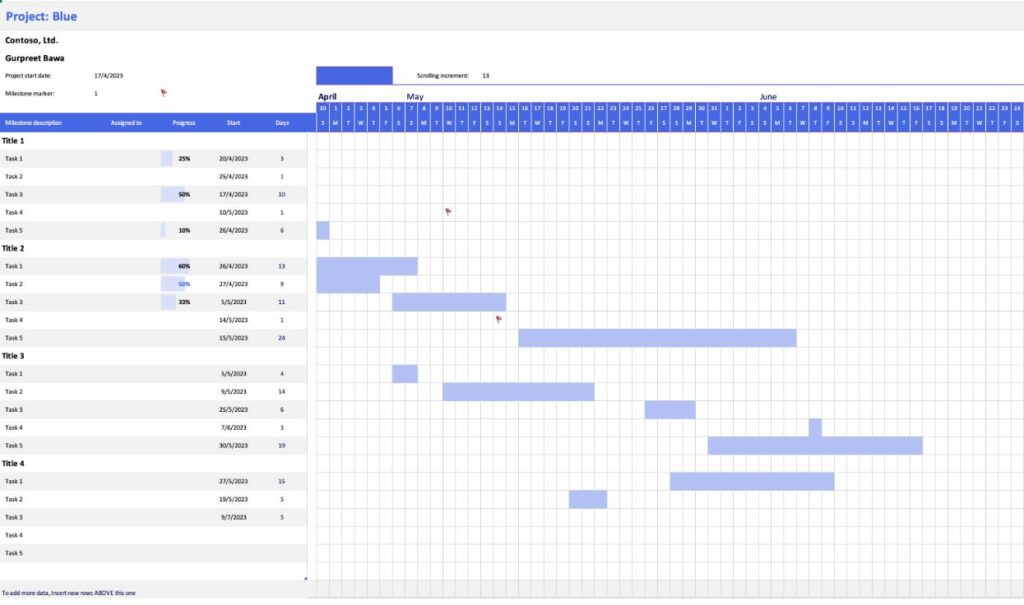Throughout the process of planning your project, you’ll have to outline the tasks, subtasks, dependencies, timeline, relevant team members, and objectives. During this planning stage, it’s essential to break your project into smaller phases or stages. This is where project milestones come in.
In this article, we’ll be discussing the definition and importance of project milestones, the benefits they bring to project managers and team members, and how to use them when planning and monitoring projects, regardless of your industry.
Key Takeaways
- A project milestone is a significant event, deliverable, or stage that marks progress towards the project’s completion.
- Project milestones are important because they help project managers track progress, manage expectations, and ensure that the project meets objectives.
- Milestones differ between industries because each industry has its own unique requirements, timelines, and project deliverables.
What are project milestones and why are they important?


Project milestones are specific and measurable events and dates that mark significant points in a project timeline, breaking complex projects into manageable stages. They’re an important part of the project planning process, serving as a way to help teams and stakeholders track progress and ensure that the project is on track to meet goals and deadlines.
Milestones are a form of a Work Breakdown Structure (WBS): project management tools that takes a step-by-step approach to break down large projects. It improves productivity across the board, giving team members, stakeholders, and other relevant people insight into
Benefits of Project Milestones
Milestones are important to businesses and their project teams because they provide clear checkpoints to track progress, communicate success, and identify potential issues before they become bigger problems that delay other project phases.
They also help keep teams aligned and motivated to achieve project goals.
Other benefits include:
- Provides clear objectives. Milestones define the critical points in a project and give a clear understanding of and context for what needs to be accomplished at each stage. This is especially beneficial for teams with remote workers, ensuring that virtual teams remain collaborative and motivated.
- Enhances project communication. By setting clear milestones, project teams can easily communicate progress to stakeholders, identify challenges, and make necessary adjustments.
- Improves project planning. Milestones allow project teams to break down a project into smaller, more manageable pieces, making a successful execution much easier to achieve.
- Identifies potential problems early. Milestones allow teams to identify potential issues early and address them before they become bigger issues that could derail the project or cause delays.
- Enhances project management. Milestones provide a framework for effective project management and control, helping project managers stay organised, prioritise tasks, and manage resources more effectively.
Examples of project milestones for various industries


Regardless of the kind of industry you work for or the type of stakeholder your project is relevant to, project management milestones are essential for measuring project progress and reaching deadlines.
In saying that, appropriate milestones for a project or initiative will vary depending on the specific industry. Each industry requires its own unique set of expectations, timelines, and goals that need to be met.
Below, you’ll find an example of a unique milestone or project phase for 4 major industries: Corporate product development, construction companies, IT organisations, and mining businesses.
Corporate
- Completion of project planning phase. This milestone marks the completion of the planning phase of a project, where the project scope, objectives, timelines, and resources have been identified and documented in a project charter. Design approval typically happens during or soon after this phase.
- Prototype development. The development of a prototype (a preliminary version of the final product or solution), allowing for testing and evaluation of the key features, functionalities, and design.
- User acceptance testing (UAT). The completion of UAT, which is the process of testing the product or solution with end-users to ensure that it meets their requirements and expectations.
- Go-live or launch. The completion of the project and the launch of the final product or solution, typically involving a formal rollout to customers and stakeholders. This is the end of the project life cycle.
Construction
- Completion of site preparation. This milestone marks the completion of site preparation activities, such as grading, excavation, and utility installation.
- Structural completion. The completion of the structural components of the building or structure, including the foundation, framing, and roofing.
- Completion of MEP systems. The completion of the installation of the building’s mechanical, electrical, and plumbing systems.
- Substantial completion. The point at which the construction project is sufficiently complete and the owner can occupy or use the structure for its intended purpose.
I.T.
- Completion of requirements gathering. This milestone marks the completion of the process of planning, gathering, and documenting the requirements for the project, such as the desired features, functions, and performance metrics for the system or application.
- Completion of software development. The completion of the software development phase of the project, where the developers have created and tested the software solution.
- Completion of system testing. The completion of the system testing phase, where the system or software is tested as a whole to ensure that it meets the requirements and functions correctly.
- Deployment or launch. The final deployment or launch of the IT project. The I.T. project manager may include a rollout to end-users and clients, training, and any necessary support or maintenance activities.
Mining
- Completion of exploration phase. This milestone marks the completion of the exploration phase of the mining project, where the potential resource is identified and evaluated, and the feasibility of mining is assessed. Once project approval is achieved, it’s time to move on to the next stage.
- Completion of pre-feasibility study. The completion of the pre-feasibility study, which assesses the technical and economic viability of the mining project, and helps to determine whether to proceed with a full feasibility study.
- Completion of construction. The completion of the construction phase of the mining project, which includes the development of the mine infrastructure, such as roads, power lines, and water treatment facilities.
- First production. The first production of the mineral or metal from the mine, representing a significant achievement in the project timeline.
Using milestones as a project manager


As a project manager, using milestones is essential to ensure that the project stays on track and meets its objectives. Milestones provide clear and measurable goals that keep the team members focused and motivated, all while providing a means of tracking progress and identifying potential issues.
Below is a guide to help you start introducing milestones to each project plan and schedule.
Creation
To create effective project milestones, you should start by identifying your project’s objectives, scope, and requirements. Based on this list of information, you can break the project down into smaller, more manageable phases and tasks, and set milestones to mark the completion of each major task.
It’s important to ensure that each milestone is specific, measurable, achievable, relevant, and time-bound — much like a SMART goal. Each milestone should be clearly defined and include a specific deliverable, deadline, and any other necessary resources or dependencies.
Tracking
Tracking milestones involves monitoring progress against the defined milestones and ensuring that the project stays on track. As a project manager, tracking milestones can help identify potential issues early on, enabling your team to take corrective action as soon as possible.
You can also use project management software or tools to track milestones and automate notifications and alerts for upcoming milestones or potential delays. By consistently tracking your milestones, you can maintain project control and visibility, anticipate issues and delays, and ensure that the project stays on track to meet client and company objectives.
Management
Managing milestones is a critical responsibility for project managers. It involves tracking and adjusting each project milestone as needed to ensure that everything stays on track to meet objectives and deadlines. Effective milestone management requires a combination of planning, monitoring, and communication skills.
To manage milestones effectively, you should work closely with your team to ensure that each milestone is achievable and aligned with project goals. Regular communication with stakeholders and team members guarantees that everyone involved is aligned and working towards the same objectives.
Following these project milestone steps is essential to ensure that the project is on time and within budget.
Common challenges with milestones
Something to keep in mind is that there are several potential challenges that project managers may encounter when working with milestones.
Unrealistic milestones
One of the most common and significant challenges is setting realistic and achievable milestones that are aligned with the project’s scope and objectives. If milestones are too unrealistic, it can lead to frustration, an unmotivated project team, and missed deadlines.
Delays caused by poor tracking
Another challenge is tracking and managing milestones effectively. Project managers need to consistently monitor progress against milestones and communicate any delays or potential issues promptly. Without proper tracking and management, milestones can become outdated, irrelevant, or missed entirely, leading to delays and potential cost overruns.
Effective communication with stakeholders and team members
Project managers may encounter challenges in communicating milestones effectively with stakeholders and team members. Milestones must be communicated clearly, with an appropriate level of detail and in a way that everyone involved can understand. Everyone must be aligned on the project’s milestones, priorities, task dependencies, deliverables, and the consequences of any delays or missed milestones.
By proactively addressing these common challenges, you can ensure that milestones remain effective tools for managing your projects and achieving your goals.
Unlock the secret to project management success with milestones
By the time you close a project, you should have several ways of measuring your progress, the quality of your workflow, and how closely you and your team were able to follow the project schedule.
Milestones can make a world of difference in your business’s project management, planning, and execution. Project deliverables will have more clarity, meetings will hold more purpose, and your team members will have a clear idea of what marks project success.
If you’re ready to begin the implementation of milestones into your project plans, Priority Management is here to get you the results you need. With over 40 years of experience, our project management experts will help you learn how to create a milestone chart, give relevant milestone updates to your team, and master milestone planning for long-term success and efficiency.
Our project management courses will teach you and your team members how to effectively use time management tools, processes, and methodologies. This will improve your project scheduling and delivery, so you can make better decisions throughout the duration of your project timelines.
If you have any questions, get in touch with one of our management training specialists – CALL: 1300 139 126
